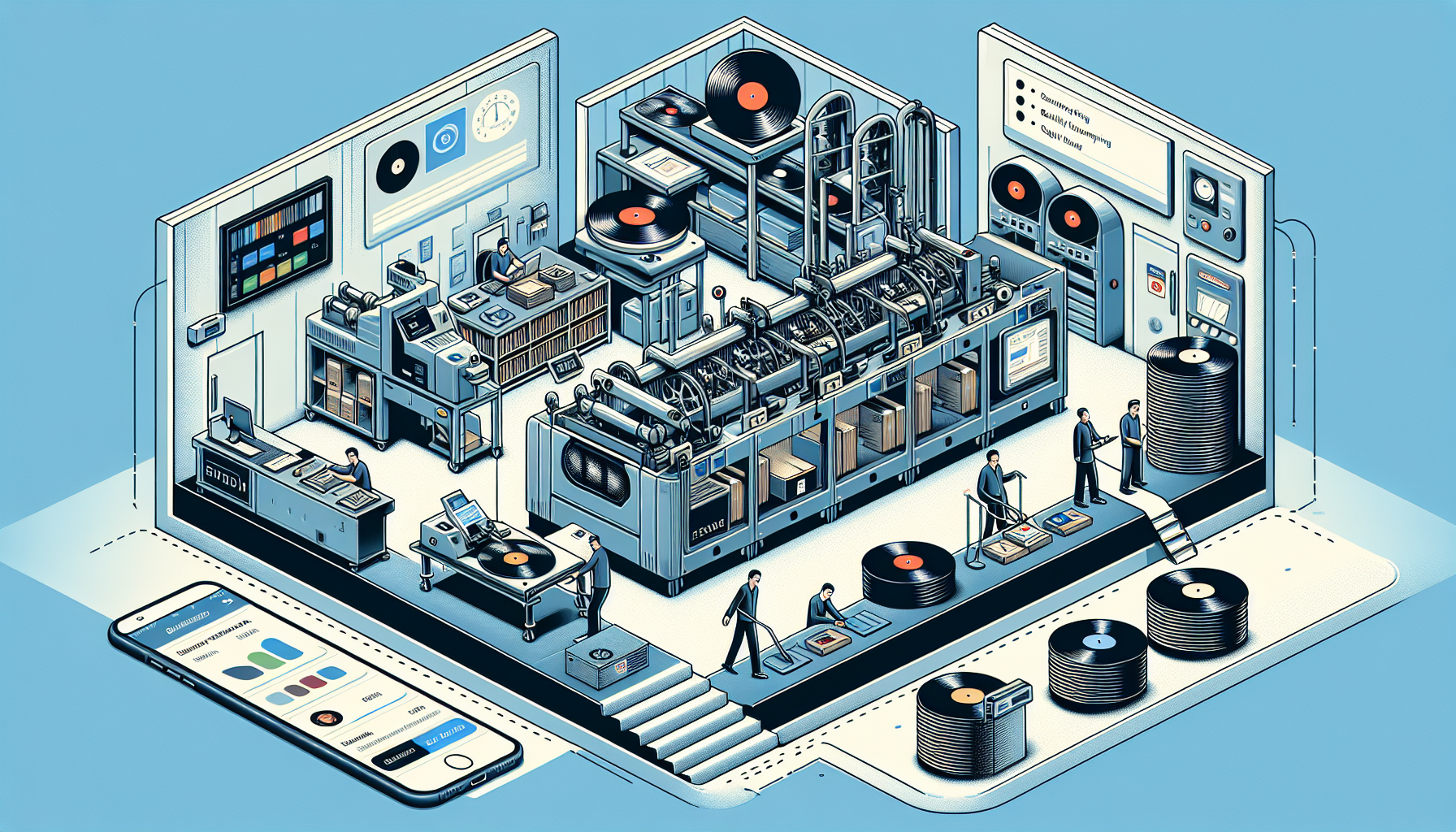Digital Archaeology Meets Analog Passion: Navigating the Online Vinyl Renaissance
In the ever-evolving landscape of digital transformation, it's fascinating to witness the sustained and growing renaissance of analog technologies. The vinyl record market stands as perhaps the most prominent example of this phenomenon. As reported in a recent Wired article, even in 2025, vinyl enthusiasts are increasingly turning to specialized online platforms to build their collections, eschewing mainstream retailers for more curated experiences.
This resurgence represents more than mere nostalgia—it highlights how technology can facilitate rather than replace traditional experiences, creating hybrid ecosystems where digital discovery leads to analog enjoyment. This intersection of old and new technologies offers valuable insights for businesses navigating their own digital transformation journeys.
The Specialized Marketplaces Revolutionizing Collection Building
According to Wired's analysis, vinyl collectors in 2025 are no longer limited to local record shops or major e-commerce giants. Specialized platforms have emerged as the primary channel for serious collectors. Discogs, which began as a music database, has evolved into the preeminent marketplace for vinyl trading, offering an exhaustive catalog and authentication features that mainstream retailers simply cannot match.
What makes these platforms revolutionary is their integration of community-driven databases with commercial capabilities. Discogs, for instance, combines:
- Comprehensive cataloging with detailed pressing information
- Condition grading standards enforced by community oversight
- Price history analytics showing market fluctuations
- Collection management tools that integrate with playback apps
- User-to-user transactions with specialized protection systems
This ecosystem represents a specialized infrastructure that balances digital convenience with the authentication requirements unique to physical media collecting. The parallel to specialized DevOps tools and platforms is striking—both serve communities with specific needs that general-purpose solutions cannot adequately address.

The Technology Behind Trust in Peer-to-Peer Marketplaces
The vinyl renaissance highlights a fascinating technological challenge: how to create trust in peer-to-peer marketplaces dealing with physical goods of variable condition. The solutions implemented by platforms like Discogs and specialized eBay communities offer valuable lessons for any organization building platforms where trust is paramount.
These marketplaces have developed sophisticated systems that include:
- Standardized condition grading with detailed description requirements
- Reputation systems with weighted scoring based on transaction complexity
- Escrow-like payment handling that protects both parties
- AI-assisted authentication tools that flag suspicious listings
- Dispute resolution workflows with specialized mediation
Perhaps most interesting is how these systems operate without centralized authentication—instead distributing trust through community consensus mechanisms. This approach resembles the trust models in modern distributed systems, where verification happens across multiple nodes rather than through a central authority.
Data-Driven Collection: How Analytics Are Transforming Collecting Behaviors
The vinyl ecosystem described by Wired reveals how modern collectors leverage data analytics to make informed acquisition decisions. Far from the random crate-digging of previous eras, today's collectors employ sophisticated tools that track:
- Market valuation trends across specific pressings
- Inventory availability across global markets
- Condition distribution analysis of available copies
- Price prediction algorithms based on historical data
- Rarity metrics that quantify scarcity across variants
These tools transform collection building from an intuitive to a data-informed process. The parallels to business intelligence in enterprise settings are clear: both contexts involve making resource allocation decisions based on data analysis rather than gut feeling or limited information. The vinyl marketplace effectively demonstrates how specialized data analytics can thrive in seemingly niche environments.
Physical Media in a Streaming World: The Hybrid Experience Economy
What makes the vinyl resurgence particularly relevant to technology strategy is how it exemplifies the emergence of hybrid experience models. In an era where music streaming offers instant, unlimited access, the deliberate choice to engage with physical media represents a countertrend worth analyzing.
Vinyl collectors frequently maintain both streaming subscriptions and physical collections, using each for different contexts and purposes. This hybrid approach offers important insights for businesses navigating digital transformation:
- Digital and physical experiences can complement rather than cannibalize each other
- Tangibility and ownership retain psychological value even in subscription economies
- Discovery often happens digitally, while premium experiences may remain physical
- Communities form around specialized knowledge that bridges digital and physical domains
This hybrid model challenges the binary thinking that often characterizes digital transformation discussions. Rather than viewing technologies as replacements, the vinyl ecosystem demonstrates how they can create new value by forming symbiotic relationships with traditional formats.
Supply Chain Visibility: From Pressing Plant to Doorstep
Another fascinating aspect of the modern vinyl marketplace is the unprecedented visibility into manufacturing and distribution processes. New platforms highlighted in the Wired piece offer collectors real-time information about:
- Pressing plant capacity and backlogs
- Production runs with batch-specific quality metrics
- Transit tracking with condition monitoring
- Authentication verification through pressing-specific identifiers
- Carbon footprint calculations for shipping options
This level of supply chain transparency would have been unimaginable in the original vinyl era. Today, it represents a microcosm of how digital technologies can transform physical product ecosystems through information availability and verification capabilities.

Community-Driven Governance: Lessons from Collector Marketplaces
Perhaps the most valuable lesson from specialized vinyl marketplaces comes from their governance models. These platforms have successfully implemented community-driven rules and standards that evolve through structured feedback mechanisms. This governance approach includes:
- Expert committees that develop grading standards
- Transparent rule modification processes with community input
- Tiered enforcement systems based on violation severity
- Knowledge sharing mechanisms that educate new participants
- Reputation systems that reward consistency and accurate descriptions
These governance models have direct parallels to open-source software communities and modern DevOps practices, where standards emerge from practitioner consensus rather than top-down imposition. For organizations implementing collaborative technologies, these marketplaces demonstrate how to balance structure with flexibility in community-driven environments.
Implications for Enterprise Technology Strategy
For Binbash Consulting clients navigating their own technology ecosystems, the vinyl marketplace renaissance offers several valuable insights:
- Specialized platforms thrive alongside generalist solutions - Just as vinyl collectors maintain both Spotify accounts and Discogs collections, enterprises benefit from both general-purpose and specialized technology solutions. The key is understanding which contexts demand specialized tools.
- Community knowledge creates sustainable value - The collective expertise in vinyl marketplaces creates barriers to entry for potential competitors. Similarly, organizations that foster internal communities of practice around their technology stacks build sustainable competitive advantages.
- Data infrastructure enhances traditional experiences - Rather than replacing physical media, digital tools enhance the vinyl collecting experience. This pattern suggests opportunities for augmenting rather than replacing established business processes with digital layers.
- Trust systems can scale without centralization - The distributed trust mechanisms in vinyl marketplaces demonstrate how organizations can build confidence in decentralized systems through well-designed verification processes.
These insights are particularly relevant for organizations implementing DevOps practices, where specialized tools, community knowledge sharing, and distributed trust models all play critical roles in successful implementations.
Conclusion: Bridging Digital and Physical in Technology Strategy
The thriving vinyl marketplace ecosystem described by Wired offers a compelling case study in how digital and physical experiences can complement each other. Rather than viewing technologies as replacements, organizations can identify opportunities to create hybrid models that leverage the strengths of both established and emerging approaches.
At Binbash Consulting, we help clients navigate similar intersections between established systems and emerging technologies. Whether implementing infrastructure as code, container orchestration, or automated compliance frameworks, the principles remain consistent: successful technology integration enhances rather than simply replaces existing value.
As we assist organizations with their cloud transformation journeys, we frequently draw inspiration from unexpected domains that demonstrate successful digital evolution. The vinyl marketplace renaissance stands as a powerful reminder that technology adoption isn't a zero-sum game—sometimes the most valuable innovations come from thoughtfully connecting the old and the new.

